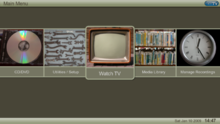Type a search term to find related articles by LIMS subject matter experts gathered from the most trusted and dynamic collaboration tools in the laboratory informatics industry.
 A screenshot of MythTV's main menu in the default theme, Terra | |
| Developer(s) | Isaac Richards |
|---|---|
| Initial release | April 10, 2002 |
| Stable release | 34
/ 10 February 2024 |
| Repository | |
| Written in | C, C++ |
| Operating system | Linux, FreeBSD, macOS, Windows (playback only) |
| Type | Digital video recorder |
| License | GNU GPL |
| Website | www |
MythTV is a free and open-source home entertainment application with a simplified "10-foot user interface" design for the living room TV. It turns a computer with the necessary hardware into a network streaming[1] digital video recorder, a digital multimedia home entertainment system, or home theater personal computer.[2] It can be considered a free and open-source alternative to TiVo[3] or Windows Media Center. It runs on various operating systems, primarily Linux, macOS, and FreeBSD.[4]
The MythTV project was started in April 2002 by Isaac Richards,[3] who explained his motivation:[5]
I got tired of the rather low quality cable box that AT&T Broadband provides with their digital cable service. It's slow to change channels, ridden with ads, and the program guide is a joke. So, I figured it'd be fun to try and build a replacement. Yes, I could have just bought a TiVo, but I wanted to have more than just a DVR – I want a web browser built in, a mail client, maybe some games. Basically, I want the mythical convergence box that's been talked about for a few years now.
MythTV is capable of capturing HDTV streams from any source that will provide unencrypted video. This means broadcast ATSC and DVB content, as well as encrypted DVB content when using a tuner with an integrated CI module. Most U.S. cable and satellite providers use encrypted video only accessible through their own set-top boxes. Cable systems may provide some unencrypted QAM channels, but these will generally only be local broadcast stations, and not cable programming or premium channels.
OpenCable devices are available to access encrypted content on U.S. cable systems, but as this is a full DRM system, and not just CA like DVB CI, every piece of hardware and software on the playback chain must be tested and licensed by CableLabs. At current, Windows Media Center is the only DVR software to meet these requirements, and only it, and other software using its recording libraries, can use these devices. In 2010, CableLabs relaxed the DRM restrictions allowing unlicensed devices to record copy freely content using these devices,[6] however it is still entirely up to cable operators what content they provide flagged as such.
As an alternative to direct digital capture, one can use an external decoder to receive the channels, and then capture using digital-analog-digital conversion (the analog hole). A popular means of doing this conversion is to connect the component outputs of a set-top box to the Hauppauge HD PVR.[7][8]
MythTV's add-on modules (plugins) include:
The base system integrates with its modules. A system can be controlled with an infrared remote control using LIRC, or radio remote control using kernel modules.
MythTV is available for many operating systems based on Linux or Unix, including Mac OS. The MythTV website distributes only source code, which must be compiled for the desired system; executable programs can be downloaded from various third-party sources.[9] The software runs on and is officially supported by Microsoft Windows, but as of January 2013 no official executable version was available; there are detailed instructions for compiling for Windows.[10] All core frontend features work under Windows, including LiveTV, scheduling, and watching recordings, but most plugins do not work without additional patches.[11]
Notable projects that include a Linux distribution bundled with MythTV (and associated libraries) are: